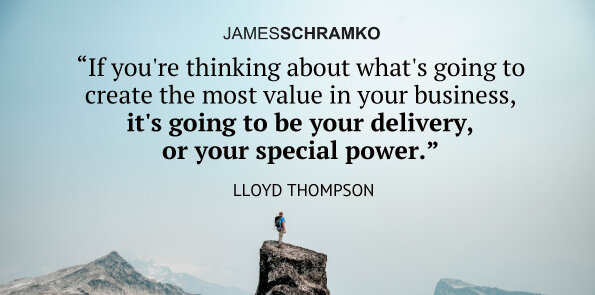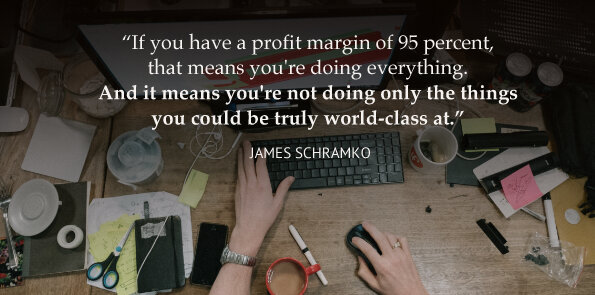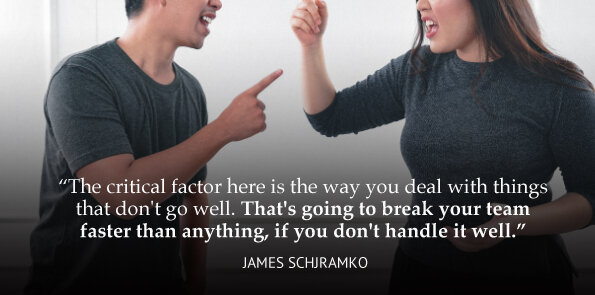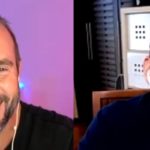Podcast: Download (Duration: 43:50 — 40.9MB)
Get Notified Of Future Episodes Apple Podcasts | Spotify | Amazon Music | Android | Blubrry | Gaana | TuneIn | Deezer | Anghami | RSS | More
The role of a business owner is ideally to strategize for and market their business. Many, however, find themselves stuck in the daily operations of their company.
VirtualDOO’s Lloyd Thompson has written a book designed to free entrepreneurs from just such a situation. In this guest appearance, he and James discuss three ways to leave your day-to-day operations.
Our experts talk about the all important element of team, and how to run an effective team meeting.
You’ll hear about the usefulness of a business dashboard.
And James and Lloyd will discuss when it’s time to ask a manager to take charge, allowing you to handle the visionary aspects of your business.
Table of contents
1. Who is Lloyd’s book for?
2. First of all, you need a team
3. What a solopreneur should consider
4. The element that is meetings
5. The rhythms that keep things running
6. Looking at the reds and greens
7. The numbers that inform planning
8. Setting triggers for the future
9. Where some visionaries get it wrong
10. Keeping a check on the pulse
11. The power of unstructured meetings
12. Stop being the answer to every question
13. A model for group coaching
14. Where to go if you need help
Who is Lloyd’s book for?
First of all, James wants to know, who has Lloyd written for?
His book, says Lloyd, is about the founder who’s typically very busy and overwhelmed. They’ve been running things, been knee-deep in the daily operations, and can’t see a way to extract themselves from the business.
These founders, as a result of their involvement, have no time to work on strategies and relationships. And their businesses aren’t sellable, because how will these companies run without them?
Lloyd’s book is about freeing these entrepreneurs from the day-to-day so they have time for strategy and passions and relationships and marketing. And he proposes to do this in three ways.
First of all, you need a team
Way one Lloyd finds most applicable to the solopreneur. They’ve started a business and most of the delivery and admin is them.
If you’re thinking about what’s going to create the most value in your business, says Lloyd, it’s going to be your delivery, or your special power. So when you’re focusing on things like admin, that’s taking away from extra revenue or value that you could be generating.
So the first thing Lloyd recommends is getting a VA.
Lloyd’s first VA hire helped with his bookkeeping. And more recently, they’ve been helping Lloyd with the video snippets he puts on social media, from episodes such as this.
James, like many people, wondered at first what he would do with a VA. Sixty-five hires later, he realized he couldn’t live without them.
What a solopreneur should consider
Solopreneur, to James’s mind, is codename for having a job with yourself as boss, but you’re still doing everything.
And unless you have really humble needs, and are particularly good at something, and have got the perfect clients or a good business model, being a solopreneur is quite limiting.
The counterintuitive tip James has got is that most people are not spending enough to get to the revenue level where they could have a much easier life. So if you have a profit margin of 95 percent, that means you’re doing everything, and it means you’re not doing only the things you could be truly world class at.
And Lloyd has found that the team he hired from the Philippines is huge value for money. They’re very often degree educated with good English and a broad range of skills, and do some things much better than Lloyd, like video editing.
If you’re stumped for tasks to give your team, Lloyd suggests performing a task audit. Just look at your weekly, daily, monthly tasks you’re regularly doing, and think, should I really be doing these? Is this the most high-value thing that I should be doing?
That will help you identify what items you can move off to your team.
The element that is meetings
Moving on to way two, Lloyd has seen many founders, once they have a team, then scatter gunning that team with tasks. They don’t know any better.
To get around this, you need rhythms, and rhythms generally involve meetings.
Meetings are often the last thing founders want to do, but they don’t have to be running them. It can be a director of operations.
Now before getting in deeper, Lloyd wants to give a disclaimer. While meetings are important to rhythm, it’s also important to just kill pointless meetings, because they will just suck time from the whole team and can be low value.
And if something can be accomplished by sharing information via a Loom video, which people can consume in their own time, it’s a much better option.
Meetings need to be purposeful, and Lloyd has two tips he took from Cameron Herold’s book, Meetings suck.
One is, have a timekeeper, because it’s easy to talk on and on about something. If you have a strict agenda, however, with an allotment of, say, 10 minutes per person, or 10 minutes per topic, a timekeeper can help everyone stick to that by reminding them when they have, say, one minute left.
Second is the parking lot manager. When the discussion is going off topic and derailing focus from the meeting objective, they can say, Hey, that’s a valuable piece of information, let’s capture that for the parking lot.
If it is valuable, they can then have it scheduled for discussion at a later time.
The rhythms that keep things running
Now as far as rhythms, Lloyd has five kinds of meetings that keep things running.
First and most important is the prioritization meeting.
The prioritization meeting involves the business owner – the founder or visionary – and the director of operations. And that meeting is to work out priorities, like what is going to move the needle the most? What are the three plates that they need to spin that will make a significant impact to the business?
Once that is worked out, the director of operations will take away the decision and implement it through the team.
One of the benefits of this meeting is not just prioritization, it’s making sure that the founder and the director of operations are on the same page. And it allows that founder to have a proxy to the team so they don’t need to be the person talking to everybody and making sure things happen.
Looking at the reds and greens
The second rhythm is the team meeting.
The founder, hopefully, before the director of operations was running things, would have a regular pulse check with their team. If not, they should definitely be having one, but this can also be run by the director of operations.
For Lloyd, the focus of a team meeting is, what support do people need to get their jobs done, to make sure things are running well? And the most efficient way to look at that is some kind of measurables from each area.
Lloyd calls these the reds and greens. So it could be sales numbers – are they below a certain number and so red, or above a certain number, green?
It could be fulfillment timeframe. If it took too long it could be red, or green if accomplished by a set deadline.
Once it’s been determined what’s green or red, the director of operations can speak to the people in charge of red areas and work out what’s needed to make them green.
Do we need more staff? Do we need more money? Does the process need to be improved? Or is it the right person running this area ultimately? That’s the topic of what Lloyd calls the retros improvement meeting.
The numbers that inform planning
In James’s business, they have a daily dashboard. Someone collates the pertinent data, screenshots it, and shares it with the team. So at weekly team meetings, everyone already knows the metrics that matter, and the meeting is largely focused on what to do with that information.
Lloyd loves the dashboard idea. And as long as it’s not sensitive information, he’s all in favor of sharing it.
Interestingly, they’re not financial numbers, says James. They can tell what they need from the number of clients in each membership level, the number of podcast downloads, the number of website visitors, number of emails sent, the size of their email database – those are the trends that guide, and they inform the business’s revenue.
Setting triggers for the future
In one of James’s last team meetings, he told his team something from the back of his mind, something he hasn’t decided on yet, but would like to set a trigger for in the future.
In two months’ time, he said, let’s look at this trigger and see if we’ll activate it or not. Activating it will set in motion certain changes.
So James’s team have an enormous amount of awareness of what’s on his mind and of what the future will look like. And James gives them enough information to be confident and comfortable in their role and to have enough ability to change the impact through the work they’re doing.
What James won’t do is overwhelm his team with other things on his mind that don’t really have any consequence to them in the short term.
Where some visionaries get it wrong
James has seen visionaries unsettle their team with too much information of a negative kind, like, Oh, we’ve just lost this client. That means in a month from now, I might have to let some of you go.
And some keep changing priorities, says Lloyd, which entails a huge cost in reprioritizing people. What some visionaries don’t realize is, to wrap up what you were doing, and put that away, and then load up whatever tools you need, and get yourself in the mindset for the next thing, you lose so much time context switching.
That’s why James says, these team members are human beings, they’re not cogs in your car gearbox. Have some empathy for a fellow human.
Keeping a check on the pulse
Another element of way to leave number two, says Lloyd, are huddles.
This doesn’t have to be an actual, in-person, live Zoom meeting. It can just be a pulse check that’s run every day, where people say what they’re working on.
It might be a couple of bullet points on Slack, enough for other people to maybe say, Oh, hang on, I’m working on that too. Maybe we can collaborate.
And it’s just as important to state if someone’s blocked or need help, so they can get the support they need.
The other thing is the one-on-one. A structured one-on-one is a good thing to do periodically, says Lloyd, where you talk about goals or things you’re measuring, and so forth.
It’s also good, however, to have an unstructured one-on-one now and then, to talk about, what’s happening in your life, is everything okay? Let’s just have a catch up, a virtual Zoom coffee, whatever that looks like.
That can be very illuminating. Someone might be ready to bail out of the business, and need just one simple thing to stay on.
So it’s great to do your structured one-on-one, but having an unstructured one-on-one is also really valuable occasionally.
The power of unstructured meetings
That’s huge, says James. He’s a massive fan of unstructured.
The last Maldives trip James organized had the least structure of any trip he’d been on before. It was just assembling the best possible people to be on the boat.
And when they got on the boat, there were no facilitated meetings, no get-to-know-you dinner where everyone has to introduce themselves. Zero.
They had the most organic outcomes possible, because the right people in a contained environment, says James, will make magic happen.
Same with James’ team. They call them temperature checks, to just check in on your team and see how they’re doing.
And in-person team catchups are unstructured – just get the team there, hire out a nice place, get meals, chat, go to the beach, let people just be human and understand and know them. People respond to that.
Stop being the answer to every question
On that note, Lloyd gets into way to leave number three.
There are situations where the business owner is frustrated, overwhelmed with questions and decisions that they need to make. Lloyd gets questions like, isn’t this common sense? Why are they coming to me? Why can’t they figure this out?
And the surprising response Lloyd delivers to many is, you might be the problem.
When someone comes to you with a problem, you need to coach the solution out of them, or at least give them the expectation that, if you’re coming with a problem, I want you to at least have a crack at solving it.
So instead of solving things for people, when someone comes with a problem, look at the thinking process you went through to find the solution. Then ask them the same questions you asked yourself.
In that process, they might actually come up with solutions better than yours. And in the long run, it should enable them to think for themselves.
It is a double-edged sword though, says Lloyd – if you let your team make decisions and be autonomous, you also need to make it safe for them to fail. Because if they make a mistake and you come in with big consequences, they’re going to retreat into their shell, to their safe place, back to just following orders.
In James’s team, people can’t fail if they try. Even if they don’t get the result they want, they’ve learned something and they feed it back.
James thinks the critical factor is the way you deal with things that don’t go well. That’s going to break your team faster than anything, if you don’t handle it well.
But if you encourage people and reward good behavior and show examples of what’s going well, they will get excited about repeating that, because it’s human nature.
A model for group coaching
For completeness, Lloyd would just like to mention what facilitation for group coaching can look like.
Say there’s a problem, and you don’t want the founder coming up with the solution. How do you get the solution out of the team?
In a previous episode, Lloyd has shared the framework, GROW, which stands for Goal, Reality, Options and Wrap up.
So he would run a meeting, whether virtual or in person, and start by stating the goal.
Say a server has melted down. The goal is to understand why, but also, what can be done to prevent it ever happening again?
Next thing is the reality. Where are we now? This is a key point where he’ll try to suck in the rest of the team to get involved.
He will draw what the current state looks like, in a series of boxes and arrows, maybe on a virtual whiteboard. And techies in particular can’t stand things being the least bit wrong, so people on the team will try to correct things, and he’ll let them take over.
That brings them to options. Lloyd will invite the team to come up with possible solutions, and from those pick the best one.
Having chosen a solution, they can then wrap up the meeting.
In summary, says Lloyd, if you’ve done all of these things well – you’re coaching, you’re delegating rather than deciding, and you’re getting your team to run things for you, then this does allow you to step back. You’ve got your director of operations running your team meeting, you’ve got your administration taken care of, you can ease out of the day-to-day, and this allows you time to focus on relationships, passion, strategy – plus you have a sellable business.
On the flip side, if you are doing all of these things, if you are leading by example, and you’re not getting results, then you probably need to take a hard look at your team members and make sure you’ve got the right people in the right seats, because you might not.
Where to go if you need help
Lloyd seems quite knowledgeable on this stuff, says James. Is he helping people do this?
Absolutely, says Lloyd. They provide a director of operations service at a low fractional cost. Meaning, people can just pay a retainer to access a team, instead of hiring one individual at $150,000 or $200,000 a year.
It’s a month-to-month subscription – people will get the service of Lloyd’s team, headed by a director of operations, and that director of operations will quite often be running a couple of different businesses. And the benefit there is they’ve often dealt with a lot of potential problems already in the course of their work.
In some cases, too, says James, Lloyd helps people people bridge the gap between working with Lloyd to actually hiring their own DOO.
That’s right, Lloyd affirms. They’re there to make themselves redundant.
But their ultimate goal is to make it a team-run business, make things as smooth as possible. And they can help by even hiring for other positions like HR or an operations and administrative assistant.
If you’re interested, Lloyd and his team are at VirtualDOO.com.
And you can get Lloyd’s book, 9 Ways to Leave Your Day-to-Day Operations, on Amazon, or on Lloyd’s website, virtualdoo.com/book.
Liked the show? Leave us a review on iTunes













Leave a Reply